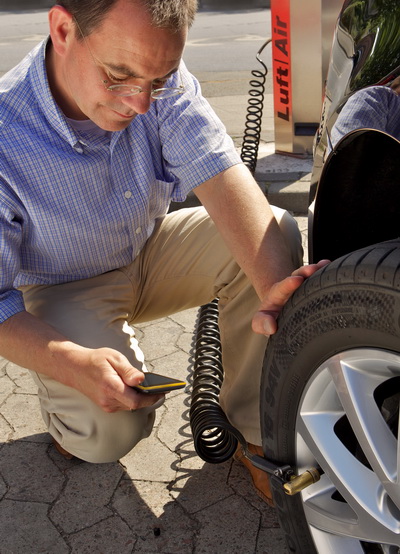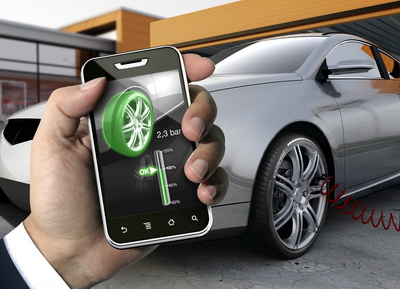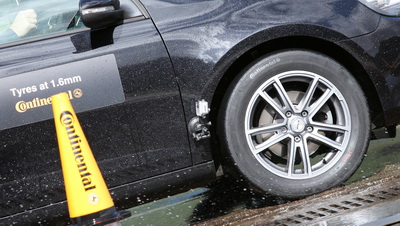If we asked you when you last checked your car tyres, what would the honest answer be? When it comes to replacing your car tyres, what is the controlling factor? For many, the answer to the first question is met by a long pause while the second answer is nowadays determined more and more by perceived value, which is why we've travelled to Hannover to get some insights into new tyre technology from Continental.
Many people tend to pay little attention to their car tyres, usually only replacing them when the car is in for a service, which is a little strange when you consider that your tyres are the only thing connecting you with the road. As tyres wear down they can radically change the handling characteristics of your car as well as making an impact on your fuel consumption.
For the first of many tests, we were given a standard automatic BMW 118i equipped with new Continental tyres and asked to drive around a test track fed by a sprinkler system to replicate a wet day. Barring a few slight slips and slides on the tighter corners the car was well able to carry out the task. We were then given an identical car with budget tyres that were of equal thread depth, so naturally there shouldn't be too much difference, right?
Very wrong. Entering the very first corner, carrying the same 40km/h, the back end of the car immediately - and without any real warning - snapped out, like it had hit a patch of ice. Despite my best efforts to maintain the same driving line and speeds as my previous run the car simply could not perform in anyway close to how a similar car on Continental's tyres could do.
Over the course of a lap the difference was almost fifteen seconds, which, according to Continental's tyre engineers, is virtually all to do with the difference in tyre compounds used rather than the thread pattern of both types of tyre. For me the sheer feeling of instability while driving on the cheaper tyres, in what were only average wet conditions, was shocking.
In the next test, we drove three identical Volkswagen Golfs, each fitted with the same tyres with the only difference being the tyre thread depth: 8-, 3- and 1.6mm. For this exercise we would drive each car through 5mm of standing water on a gentle bend. At a steady 60km/h and with 8mm of tyre thread depth there was virtually no noticeable change in handling when driving through the standing water, yet when taken at the same speed with 3mm of tyre there was an immediate effect to be felt. The front end slides away suddenly across a distance more than sufficient to send a car onto the wrong side of the road.
Carrying out the same exercise with 1.6mm of tyre was, frankly, frightening. The car instantly lost all front-end grip, snapped violently out of control and needed all of my steering input as well as the car's on-board safety systems to bring the car back into line. Were this to happen on a normal road I would have likely hit a kerb, at the very least. What makes this test particularly scary is that it is legal to drive with tyres of this thread depth on the road.
One other factor which can have implications on your car tyre performance is just how well they are inflated. Studies have shown that in a lot of cases car tyres are not kept at the recommended inflated pressure. This causes a number of issues; the tyre can wear prematurely, it can increase fuel consumption and can affect your car's handling. It seems the majority of car drivers do not regularly check their tyre pressures, which Continental says can cost European motorists up to 20 million litres of fuel per year.
The flip side to this is that, for those that do try to keep their tyre pressures in check, a huge number of petrol stations do not correctly calibrate their air systems, so drivers are often, unknowingly, putting the wrong amounts of air into their tyres. The only real solution it would seem is to spend a couple of Euro on your own pressure reader, which, given how much fuel it might save, could be a worthwhile investment.
Continental did show a glimpse of the not too distant future in the form of a smartphone app that can relay each tyre's pressure to it, which not only warns you should you develop a slow puncture for example, but also assists you when inflating your tyre. Taking this one step further, engineers have been able to link this into the car's on-board computer and when the tyres reach their recommended tyre pressure the car's horn chirps once to let you know when to stop. Quite simple yet very clever technology.
The day demonstrated that not only is buying 'cheaper' tyres a false economy, it can have huge potential implications on safety grounds. What left an equally big impression was that our legislators are happy to pass laws allowing us to be able to legally drive on tyres so worn down that they, in my opinion, clearly pose a threat to driver safety. I agree that consumers need to get value for money from consumable items such as tyres, but if it were possible to bottle the experiences I had on 'lesser' tyres and let consumers sniff it, I feel the vast majority would very soon change their buying habits.








